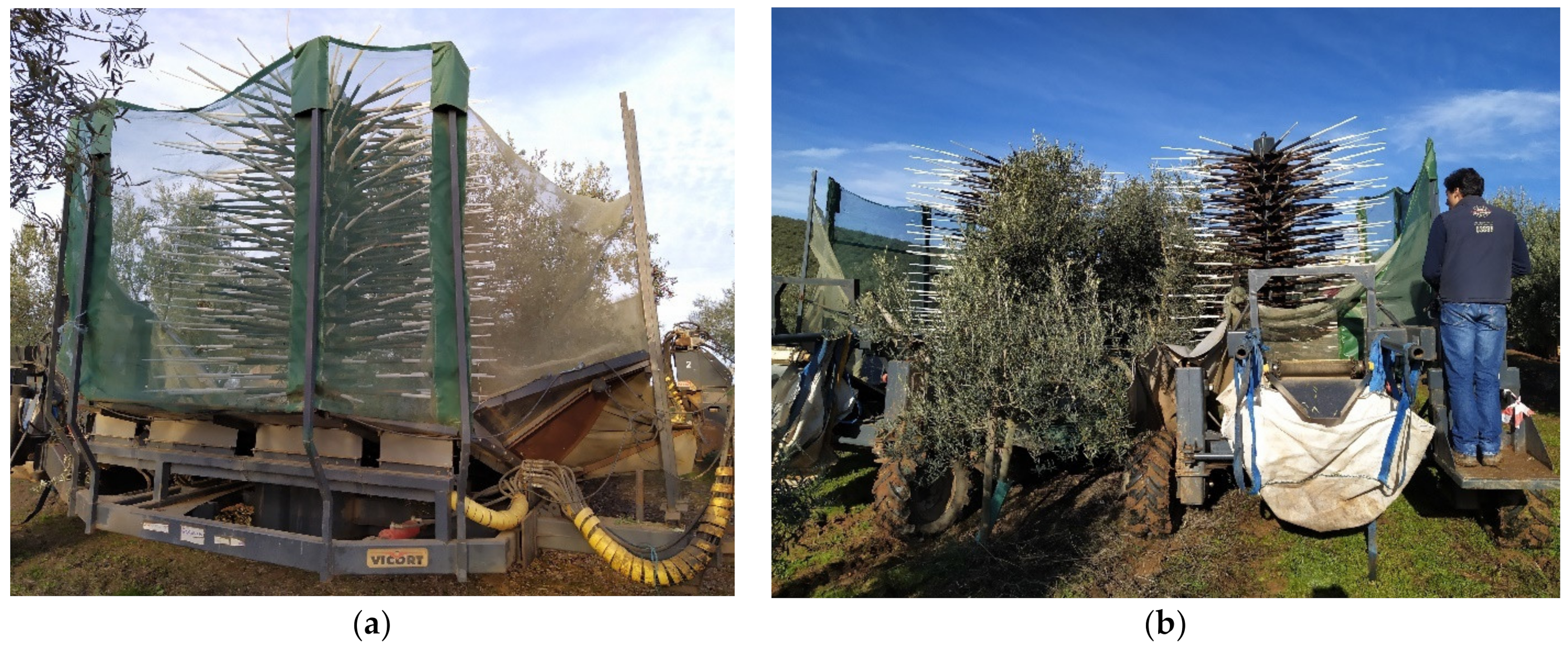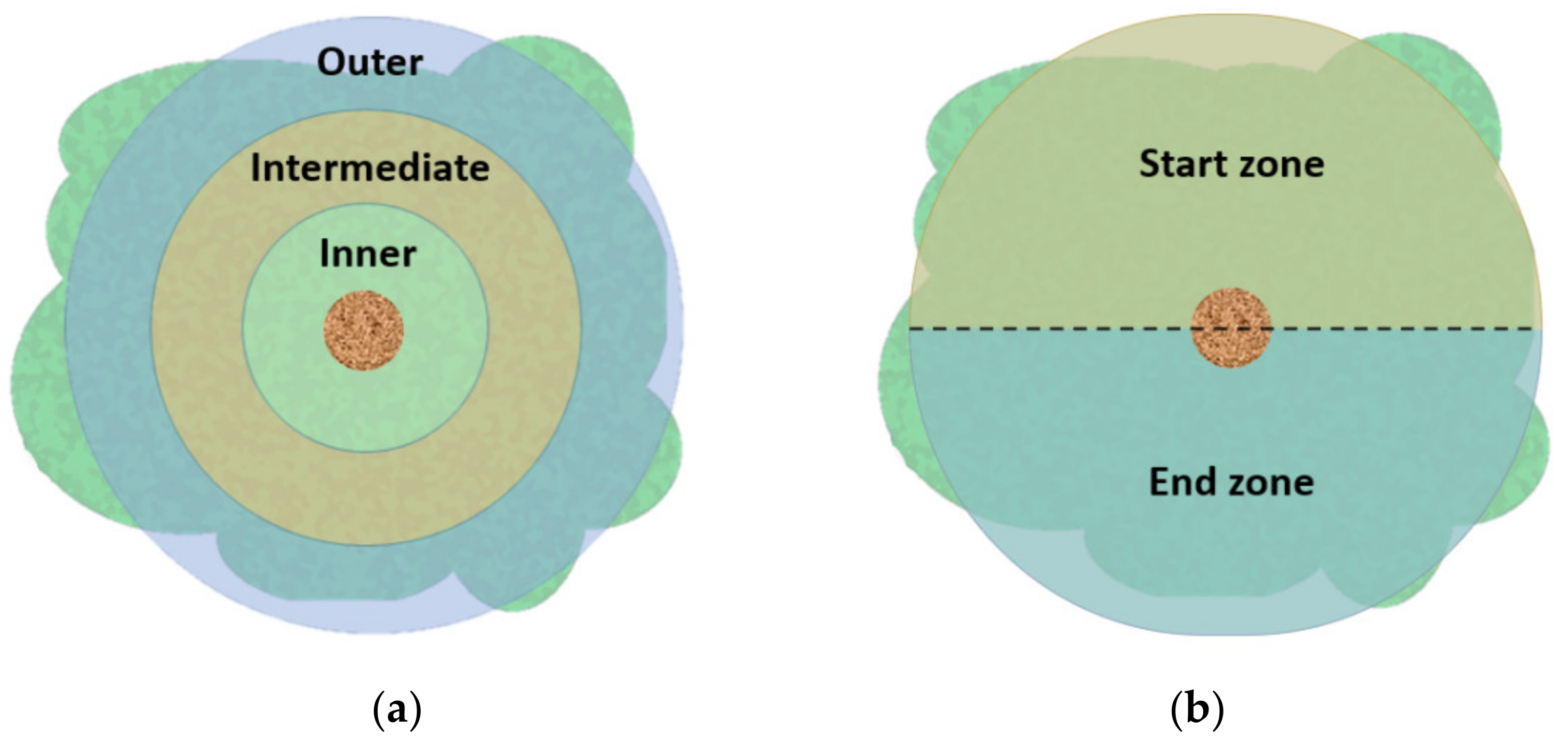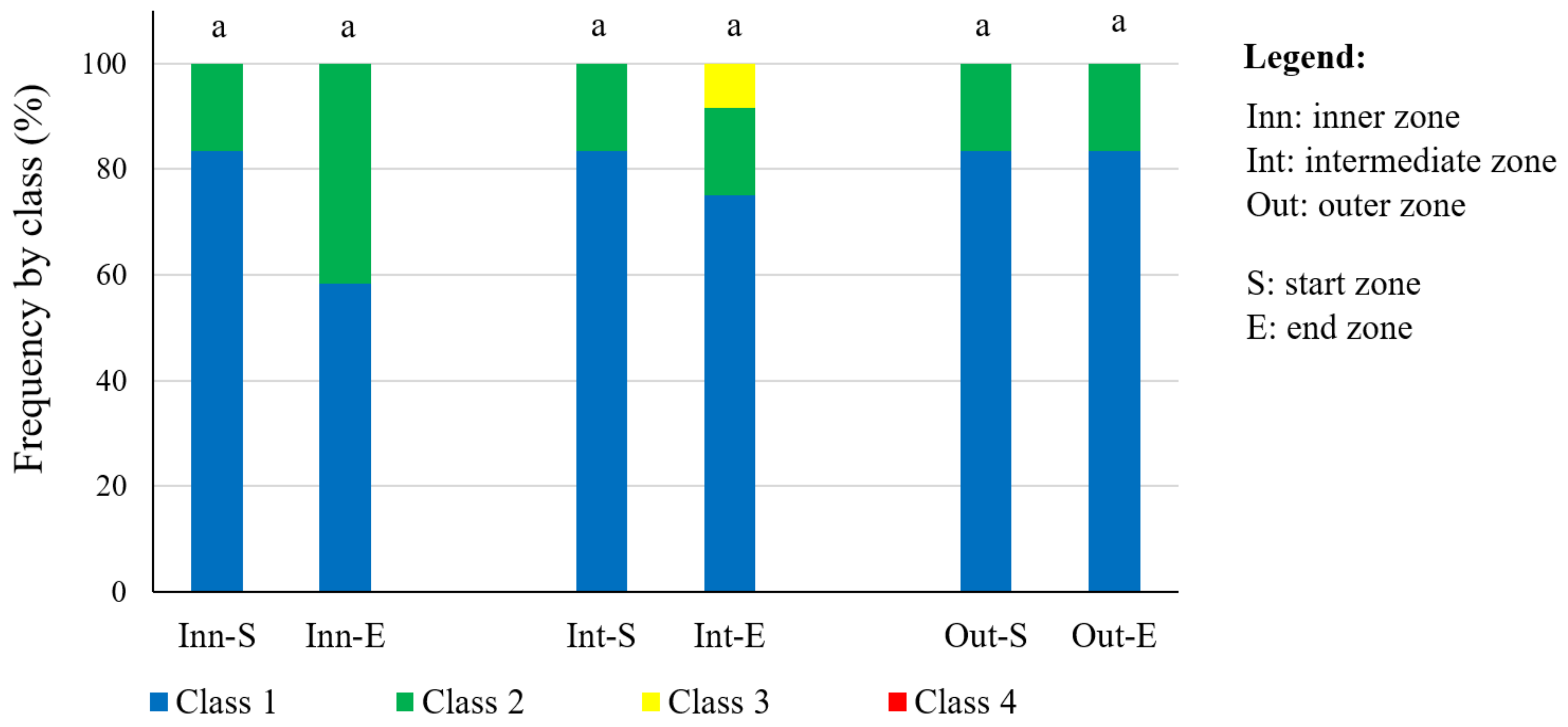Assessment of a Side-Row Continuous Canopy Shaking Harvester and Its Adaptability to the Portuguese Cobrançosa Variety in High-Density Olive Orchards
Abstract
1. Introduction
2. Materials and Methods
- Vibration time: time that elapsed between the first and the last event with a value over a resultant acceleration range. The beginning and end of the forced vibration on the tree branch was determined by measuring the vibration without any excitation except the action of natural phenomena in the 100 s before and after harvesting.
- Resultant acceleration (Ar) (m s−2): vector sum of the three measurement axes (x, y, z) on each sensor.
- Peak acceleration (Apk): the 30 maximum values of peaks in resultant acceleration in the time domain, considering the sampling frequency and the vibration frequency.
- Crest factor: ratio between peak acceleration (Apk) and the RMS value of the resultant acceleration (Ar).
- Frequency: number of cycles of rod movement in the canopy per second (Hz).
- RMS acceleration (ARMS): vector sum of the root mean square (RMS) values of each accelerometer axis at the vibration frequency.
3. Results
3.1. Vibration Signals
3.2. Evaluation of Mechanised Harvesting
4. Discussion
5. Conclusions
Author Contributions
Funding
Institutional Review Board Statement
Informed Consent Statement
Data Availability Statement
Conflicts of Interest
References
- Almeida, A.; Peça, J.; Pinheiro, A.; Dias, A.; dos Santos, L.S.; Reynolds, D.; Lopes, J. Performance of three mechanical harvesting systems for olives in Portugal. In Proceedings of the 35th International Symposium on Agricultural Engineering, Opatija, Croatia, 19–23 February 2007. [Google Scholar]
- Sales, H.; Nunes, J.; Vaz Patto, M.C. Achievements and challenges towards a sustainable conservation and Use of ‘Galega vulgar’ Olea europaea variety. Agronomy 2020, 10, 1467. [Google Scholar] [CrossRef]
- FAOSTAT. Data of the Olive Crop. Available online: https://www.fao.org/faostat/en/#data/QCL (accessed on 11 December 2022).
- INE. Recenseamento Agrícola. Available online: https://www.ine.pt/ngt_server/attachfileu.jsp?look_parentBoui=491811570&att_display=n&att_download=y (accessed on 11 December 2022).
- Dias, A.B.; Peça, J.O.; Pinheiro, A. Long-Term Evaluation of the Influence of Mechanical Pruning on Olive Growing. Agron. J. 2012, 104, 22–25. [Google Scholar] [CrossRef]
- Rallo, L.; Barranco, D.; Castro-García, S.; Connor, D.J.; Gómez del Campo, M.; Rallo, P. High-Density Olive Plantations. Hortic. Rev. 2013, 41, 303–384. [Google Scholar] [CrossRef]
- Gil-Ribes, J.A.; Blanco-Roldán, G.L.; Castro-García, S.; Agüera-Vega, J.; Muñoz-Tejada, R.; Jiménez-Jiménez, F. Introducción de un sistema sacudidor de copa para la recolección mecanizada del olivar tradicional de almazara. In Proceedings of the Fifteenth Scientific-Technical Symposium EXPOLIVA, Jaen, Spain, 11–14 May 2011. [Google Scholar]
- Sola-Guirado, R.R.; Castro-García, S.; Blanco-Roldán, G.L.; Jiménez-Jiménez, F.; Castillo-Ruiz, F.J.; Gil-Ribes, J.A. Traditional olive tree response to oil olive harvesting technologies. Biosyst. Eng. 2014, 118, 186–193. [Google Scholar] [CrossRef]
- Almeida, A. Appropriate mechanical harvesting systems for different types of olive orchards. In Proceedings of the VI International Scientific Symposium of Farm Machinery and Processes Management in Sustainable Agriculture, Lublin, Poland, 20–22 November 2013. [Google Scholar]
- Fernández-Escobar, R.; De la Rosa, R.; León, L.; Gomez, J.A.; Testi, F.; Orgaz, M.; Gil-Ribes, J.A.; Trapero, A. Evolution and sustainability of the olive production systems. In Proceedings of the Present and Future of the Mediterranean Olive Sector, Zaragoza, Spain, 26–28 November 2012. [Google Scholar]
- Ferguson, L. Trends in olive fruit handling previous to its industrial transformation. Grasas Y Aceites 2006, 57, 9–15. [Google Scholar] [CrossRef]
- Barranco, D.; Escobar, R.F.; Rallo, L.; Navero, D.B.; Romero, L.R. El Cultivo del Olivo, 6th ed.; Mundi-Prensa: Madrid, Spain, 2008. [Google Scholar]
- Jiménez-Jiménez, F.; Castro-Garcia, S.; Blanco-Roldan, G.; González-Sánchez, E.; Gil-Ribes, J.A. Isolation of table olive damage causes and bruise time evolution during fruit detachment with trunk shaker. Span. J. Agric. Res. 2013, 11, 65–71. [Google Scholar] [CrossRef]
- Aragon-Rodriguez, F.; Castro-Garcia, S.; Sola-Guirado, R.R.; Gil-Ribes, J.A. Fruit abscission pattern of ‘Valencia’ orange with canopy shaker system. Sci. Hortic. 2019, 246, 916–920. [Google Scholar] [CrossRef]
- Ravetti, L. Technology for improving the efficiency of mechanical harvesting in modern olive growing. Acta Hortic. 2014, 1057, 221–229. [Google Scholar] [CrossRef]
- Connor, D.J.; Gómez-del-Campo, M.; Rousseaux, M.C.; Searles, P.S. Structure, management and productivity of hedgerow olive orchards: A review. Sci. Hortic. 2014, 169, 71–93. [Google Scholar] [CrossRef]
- Famiani, F.; Farinelli, D.; Rollo, S.; Camposeo, S.; Di Vaio, C.; Inglese, P. Evaluation of different mechanical fruit harvesting systems and oil quality in very large size olive trees. Span. J. Agric. Res. 2014, 4, 960–972. [Google Scholar] [CrossRef]
- Camposeo, S.; Ferrara, G.; Palasciano, M.; Godini, A. Varietal behaviour according to the superintensive oliveculture training system. In Proceedings of the V International Symposium on Olive Growing, Evora, Portugal, 9–13 September 2008. [Google Scholar] [CrossRef]
- Godini, A.; Vivaldi, G.; Camposeo, S. Sidebar: Olive cultivars field-tested in super-high-density system in southern Italy. Calif. Agric. 2011, 65, 39–40. [Google Scholar] [CrossRef]
- Ferguson, L.; Garcia, S.C. Transformation of an ancient crop: Preparing California ‘Manzanillo’ table olives for mechanical harvesting. HortTechnology 2014, 24, 274–280. [Google Scholar] [CrossRef]
- Miranda-Fuentes, A.; Llorens, J.; Gamarra-Diezma, J.L.; Gil-Ribes, J.A.; Gil, E. Towards an optimized method of olive tree crown volume measurement. Sensors 2015, 15, 3671–3687. [Google Scholar] [CrossRef] [PubMed]
- Uceda, M.; Hermoso, M. La calidad del aceite de oliva. In El cultivo del Olivo, 2nd ed.; Mundi-Prensa: Madrid, Spain, 1998; pp. 547–572. [Google Scholar]
- Peça, J.O.; Dias, A.B.; Pinheiro, A.; Cardoso, V.; Reynolds de Souza, D.; Falcão, J.M. Side-Row Continuous Canopy Shaking Harvester for Intensive Olive Orchards. Acta Hortic. 2014, 1057, 391–397. [Google Scholar] [CrossRef]
- R: A Language and Environment for Statistical Computing; R Core Team; R Foundation for Statistical Computing: Vienna, Austria, 2022; Available online: https://www.R-project.org/ (accessed on 11 December 2022).
- Sola-Guirado, R.R.; Aragon-Rodriguez, F.; Castro-Garcia, S.; Gil-Ribes, J. The vibration behaviour of hedgerow olive trees in response to mechanical harvesting with straddle harvester. Biosyst. Eng. 2019, 184, 81–89. [Google Scholar] [CrossRef]
- Sola-Guirado, R.R.; Jiménez, F.J.; Blanco-Roldan, G.L.; García, S.C.; Ruiz, F.J.C.; Ribes, J.A.G. Vibration parameters assessment to develop a continuous lateral canopy shaker for mechanical harvesting of traditional olive trees. Span. J. Agric. Res. 2016, 14, e0204. [Google Scholar] [CrossRef]
- Castro-Garcia, S.; Aragon-Rodriguez, F.; Sola-Guirado, R.R.; Serrano, A.J.; Soria-Olivas, E.; Gil-Ribes, J.A. Vibration monitoring of the mechanical harvesting of citrus to improve fruit detachment efficiency. Sensors 2019, 19, 1760. [Google Scholar] [CrossRef] [PubMed]
- Vallone, M.; Alleri, M.; Bono, F.; Catania, P. Acceleration assessment during mechanical harvest of grapes using a non commercial instrumented sphere. Chem. Eng. Trans. 2017, 58, 277–282. [Google Scholar]
- Torregrosa, A.; Cuenca, A.; Ortiz, C. Detachment of citrus fruits with a low frequency and high amplitude shaker. In Power and Machinery, Proceedings of the International Conference of Agricultural Engineering-CIGR-AgEng; Valencia, Spain, 8–12 July 2012, CABI: Wallingford, UK, 2012. [Google Scholar]
- Pu, Y.; Toudeshki, A.; Ehsani, R.; Yang, F. Design and evaluation of a two-section canopy shaker with variable frequency for mechanical harvesting of citrus. Int. J. Agric. Biol. Eng. 2018, 11, 77–87. [Google Scholar] [CrossRef]
- Lo Bianco, R.; Proietti, P.; Regni, L.; Caruso, T. Planting systems for modern olive growing: Strengths and weaknesses. Agriculture 2021, 11, 494. [Google Scholar] [CrossRef]
- Castro-Garcia, S.; Aragon-Rodriguez, F.; Arias-Calderón, R.; Sola-Guirado, R.R.; Gil-Ribes, J.A. The contribution of fruit and leaves to the dynamic response of secondary branches of orange trees. Biosyst. Eng. 2020, 193, 149–156. [Google Scholar] [CrossRef]
- Liu, T.H.; Luo, G.; Ehsani, R.; Toudeshki, A.; Zou, X.J.; Wang, H.J. Simulation study on the effects of tine-shaking frequency and penetrating depth on fruit detachment for citrus canopy-shaker harvesting. Comput. Electron. Agric. 2018, 148, 54–62. [Google Scholar] [CrossRef]
- Deboli, R.; Calvo, A.; Preti, C. Vibration and impulsivity analysis of hand held olive beaters. Appl. Ergon. 2016, 55, 258–267. [Google Scholar] [CrossRef] [PubMed]
- Agüera-Vega, J.; Blanco, G.L.; Castillo, F.J.; Castro-Garcia, S.; Gil-Ribes, J.A.; Perez-Ruiz, M. Determination of field capacity and yield mapping in olive harvesting using remote data acquisition. In Proceedings of the 9th European Conference on Precision Agriculture, Lleida, Spain, 7–11 July 2013. [Google Scholar]
- Sarri, D.; Vieri, M. Criteria for introducing mechanical harvesting of oil olives: Results of a five-year project in Central Italy. Adv. Hortic. Sci. 2010, 24, 78–90. [Google Scholar]
- Blanco-Roldán, G.; Castillo, F.; Sola-Guirado, R.R.; Jiménez-Jiménez, F.; Castro-Garcia, S.; Agüera Vega, J.; Gil-Ribes, J.A. Olive harvesting by canopy shaker. In Proceedings of the International Conference of Agricultural Engineering, Zurich, Switzerland, 6–10 July 2014. [Google Scholar]
- Sola-Guirado, R.R.; Ceular-Ortiz, D.; Gil-Ribes, J.A. Automated system for real time tree canopy contact with canopy shakers. Comput. Electron. Agric. 2017, 143, 139–148. [Google Scholar] [CrossRef]
- Castillo-Ruiz, F.J.; Jiménez-Jiménez, F.; Blanco-Roldán, G.L.; Sola-Guirado, R.R.; Agüera-Vega, J.; Castro-Garcia, S. Analysis of fruit and oil quantity and quality distribution in high-density olive trees in order to improve the mechanical harvesting process. Span. J. Agric. Res. 2015, 13, e0209. [Google Scholar] [CrossRef]
- Gamlı, Ö.F.; Eker, T. Determination of harvest time of Gemlik olive cultivars by using physical and chemical properties. J. Food Meas. Charact. 2017, 11, 2022–2030. [Google Scholar] [CrossRef]
- Pu, Y.; Toudeshki, A.; Ehsani, R.; Yang, F.; Abdulridha, J. Selection and experimental evaluation of shaking rods of canopy shaker to reduce tree damage for citrus mechanical harvesting. Int. J. Agric. Biol. Eng. 2018, 11, 48–54. [Google Scholar] [CrossRef]
- Sola-Guirado, R.R.; Blanco-Roldan, G.L.; Castro-Garcia, S.; Castillo-Ruiz, F.J.; Gil-Ribes, J.A. Innovative circular path harvester for mechanical harvesting of irregular and large-canopy olive trees. Int. J. Agric. Biol. Eng. 2018, 11, 86–93. [Google Scholar] [CrossRef]
- Dias, A.B.; Falcão, J.M.; Pinheiro, A.; Peça, J.O. Evaluation of Olive Pruning Effect on the Performance of the Row-Side Continuous Canopy Shaking Harvester in a High Density Olive Orchard. Front. Plant Sci. 2020, 10, 1631. [Google Scholar] [CrossRef]
- Gupta, S.K.; Ehsani, R.; Kim, N.H. Optimization of a Citrus Canopy Shaker Harvesting System: Mechanistic Tree Damage and Fruit Detachment Models. Trans. ASABE 2016, 59, 761–776. [Google Scholar] [CrossRef]
- Dias, A.; Falcão, J.; Pinheiro, A.; Peça, J. Effect of Mechanical Pruning on Olive Yield in a High-Density Olive Orchard: An Account of 14 Years. Agronomy 2022, 12, 1105. [Google Scholar] [CrossRef]




| Tree Height (m) | Height from Ground to Canopy (m) | Canopy Height (m) | Perpendicular Diameter Tree Line (m) | Diameter at Tree Line (m) | Canopy Volume (m3) 3 | Production per Tree (kg) |
|---|---|---|---|---|---|---|
| 3.7 1 (0.2) 2 | 0.9 (0.1) | 2.9 (0.2) | 3.6 (0.4) | 3.9 (0.5) | 21.0 (4.8) | 22.0 (4.5) |
| Fresh Weight (FW) (g) | Detachment Force (DF) (N) | Detachment Index (DF/FW) | Ripening Index 3 | Oil Content (% Wet Weight) | Oil Content (% Dry Weight) | Moisture Content (%) |
|---|---|---|---|---|---|---|
| 3.7 1 (0.7) 2 | 2.9 (0.3) | 0.8 (0.2) | 4.2 (0.1) | 17.1 (1.5) | 38.6 (1.8) | 55.8 (2.0) |
| Frequency (Hz) | Vibration Time (s) | ARMS (m s−2) | Apk (m s−2) | |
|---|---|---|---|---|
| Right symmetrical machine | 9.22 (0.25) 1 a 3 | 50.38 (9.91) 2 a | 66.97 (40.67) 2 a | 672.6 (468.1) 2 a |
| Left symmetrical machine | 9.10 (0.34) 1 a | 48.04 (11.66) 2 a | 59.24 (44.75) 2 a | 585.8 (552.1) 2 a |
| Vibration Time (s) | ARMS (m s−2) | Apk (m s−2) | ||
|---|---|---|---|---|
| According to the direction of the forward movement of the harvester | Start zone | 53.11 (9.96) 1 a 2 | 83.80 (38.03) a | 846.0 (522.8) a |
| End zone | 46.85 (9.81) b | 53.39 (42.54) b | 526.1 (445.0) b | |
| According to the distance to the trunk | Inner zone | 45.18 (9.65) a 3 | 45.11 (40.45) a | 442.1 (456.5) a |
| Intermediate zone | 50.88 (7.42) b | 70.97 (42.98) b | 712.6 (371.1) b | |
| Outer zone | 51.77 (12.14) b | 76.25 (25.53) b | 724.5 (159.5) b |
Disclaimer/Publisher’s Note: The statements, opinions and data contained in all publications are solely those of the individual author(s) and contributor(s) and not of MDPI and/or the editor(s). MDPI and/or the editor(s) disclaim responsibility for any injury to people or property resulting from any ideas, methods, instructions or products referred to in the content. |
© 2023 by the authors. Licensee MDPI, Basel, Switzerland. This article is an open access article distributed under the terms and conditions of the Creative Commons Attribution (CC BY) license (https://creativecommons.org/licenses/by/4.0/).
Share and Cite
Aragon-Rodriguez, F.; Dias, A.B.; Pinheiro, A.; Peça, J.; Días, I.L.; Castro-Garcia, S. Assessment of a Side-Row Continuous Canopy Shaking Harvester and Its Adaptability to the Portuguese Cobrançosa Variety in High-Density Olive Orchards. Sensors 2023, 23, 1740. https://doi.org/10.3390/s23031740
Aragon-Rodriguez F, Dias AB, Pinheiro A, Peça J, Días IL, Castro-Garcia S. Assessment of a Side-Row Continuous Canopy Shaking Harvester and Its Adaptability to the Portuguese Cobrançosa Variety in High-Density Olive Orchards. Sensors. 2023; 23(3):1740. https://doi.org/10.3390/s23031740
Chicago/Turabian StyleAragon-Rodriguez, Fernando, António B. Dias, Anacleto Pinheiro, José Peça, Ivo Lourenço Días, and Sergio Castro-Garcia. 2023. "Assessment of a Side-Row Continuous Canopy Shaking Harvester and Its Adaptability to the Portuguese Cobrançosa Variety in High-Density Olive Orchards" Sensors 23, no. 3: 1740. https://doi.org/10.3390/s23031740
APA StyleAragon-Rodriguez, F., Dias, A. B., Pinheiro, A., Peça, J., Días, I. L., & Castro-Garcia, S. (2023). Assessment of a Side-Row Continuous Canopy Shaking Harvester and Its Adaptability to the Portuguese Cobrançosa Variety in High-Density Olive Orchards. Sensors, 23(3), 1740. https://doi.org/10.3390/s23031740







